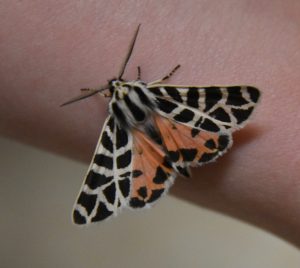Finding the beauty in moths by taking a closer look
Views: 1626

I never thought much about moths, but after this year I am finding the beauty in moths by stopping to take a closer look. At this time of the year moths are front and center nearly any time a light is turned on at night. When someone leaves the screen door open, rest assured there’s a fresh batch in the kitchen in the morning, and while some people might find their powdery fluttering annoying, after learning more about them – and taking a look at their beautiful patterns – I’ve developed a new appreciation for these nighttime wanderers.
Moths share the Lepidoptera order with butterflies, and there are roughly 11 thousand species of moths in North America. It seems that half the population ends up in the house in the summertime. While most moths are more visible at night, this isn’t always the case. We have some species, such as the sphinx moth and police car moth, tend to visit flowers during the day, while most others we never have a chance to see unless we really pay attention.
The difference between moths and butterflies
While moths and butterflies are unique in the fact that most of them have scales covering their wings and bodies, there are key characteristics that allow us to tell the two species apart.
When you look at a moth notice how it folds up its wings creating almost a tent around its body that somewhat resembles a jet plane. It looks like it’s ready to take off at any moment. A butterfly, on the other hand, folds them vertically – almost sail-like – above their bodies allowing us to know the subtle patterns underneath their wings.
Although butterflies are generally larger, you can’t use this feature as the only way to tell them apart because there are some, like the Polyphemus moth that is as large as someone’s palm, is bigger than many species of butterflies. Another consideration is moths tend to be fuzzier and chunkier versus the smooth, elegant butterflies.
Butterflies also have a slender, hooked-shaped antennae with a little ball on the end of each one, where the moths’ antennae is more blunt and feathery. What is really neat is these fuzzy appendages have scent receptors on each one of the tiny hair-like features that allows them to locate food and mates, reportedly up to 7 miles away. They also use their antennae to help them figure out the wind currents so they fly straight. Since a good number of moths feed and travel at night, being able to navigate without sight is an important characteristic.
Bright colors and hidden beauty
Butterflies are typically known for their often brilliant colors, which makes sense for a species that is active during the day showing off for mates, along with avoiding predation with the bright hues that act as warnings. Moths have the reputation for being more earth-toned and drab, but look closely to appreciate the intricate patterns. After a moth expert I know from Facebook posted the species she’s seeing this year, I started noticing the ones visiting us. The patterns are beautiful!
Impressed by the Ornate Tiger Moth
One of the most impressive ones we’ve seen so far is the ornate tiger moth, Apantesis ornata. The geometrically patterned black and cream wings caught our eyes, but we really took notice when it opened its wings with the orangish coloration at the base. After searching on the Pacific Northwest Moths site, along with putting out a shout on Facebook (where a fellow homeschool mom and amateur entomologist stepped forward with the answer) we were thrilled to learn the name of this striking visitor.
And that’s the cool thing about moths. They’re not as showy as their daytime cousins, but when you take a moment to notice them, you’ll see they are just as amazing and as important when it comes to their place in the ecosystem.
Meet Amy Grisak
Amy is a freelance author and photographer in Great Falls, MT who specializes in gardening, foods, and sustainable agriculture. She provides information on every kind…
Amy's Recent Posts

Try Your Hand at Winter Sowing to Gain a Jump on the Season








